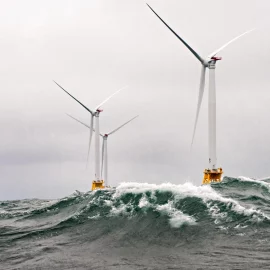
A Senate bill removing the upper limit on receipts from oil would give us more money.
Louisiana could receive an additional $1.9 billion in revenue from Gulf of Mexico oil and gas and a separate share of revenue from Gulf wind energy operations under federal legislation expected to be considered Thursday. The U.S. Senate’s Energy and Natural Resource Committee on Thursday will consider the the bipartisan Reinvesting In Shoreline Economies and Ecosystems Act, authored by Sens. Sheldon Whitehouse, D-Rhode Island, and Bill Cassidy, R-La.. That bill would lift a present $500 million annual cap on oil and gas revenue shared with Gulf states. All told, Gulf states could receive $4.4 billion more in offshore revenue over the next decade if the cap is dropped. That’s according to conservative estimates of oil and gas prices in the coming years provided by University of Louisiana at Lafayette economist Stephen Barnes. The bill would also provide a 37.5% share of federal revenue from offshore wind facilities located in federal waters to states, with amounts divvied up based on how close the wind facilities are to state borders. And yet another 12.5% of the wind funds would go to the National Oceans and Coastal Security Fund, which funds projects aimed at better understanding and using ocean and coastal resources and infrastructure. Louisiana would be eligible for a share of those grants, too.
nola.com
Sen Manchin seems to be in for this bill but with his record, who knows.
According to officials in Cassidy’s office, the consideration of the bill on Thursday is the result of an agreement between Gulf Coast and other senators with Sen. Joe Manchin, D-W.Va., who chairs the committee. The bill’s sponsors agreed to drop two provisions from the legislation that Manchin opposed: Increasing the state share of offshore oil revenue from 37.5% to 50%, and adding oil and gas operations that were leased between 2000 and 2006 to those whose revenue is shared with coastal states. The sponsors also agreed to add language guaranteeing that none of the offshore revenue would be used by states for “entertainment” purposes, such as to fund the construction of stadiums or aquariums. And Manchin insisted, Cassidy’s office said, on adding language that requires states to say precisely what they will spend the money on. Louisiana laws require offshore oil revenue to be spent only on coastal restoration or coastal flood protection projects. In recent years, the state has directed much of its offshore revenue toward levee construction projects. The spending is disclosed annually in a plan approved by the Legislature.
Removing the cap has been a long term effort by the Louisiana delegation for years.
Though Cassidy and Whitehouse introduced their bill last June, Louisiana’s congressional delegation has been fighting to remove the cap on offshore spending and increase the amount of money the state receives generally offshore energy since former U.S. Sen. Mary Landrieu, D-La., first co-authored the initial Gulf of Mexico Energy Security Act in 2006. Under that act – which authorized the cap – Louisiana received $111.8 million in fiscal year 2022, and coastal parishes shared $22.8 million of that amount. The act allows Gulf states to receive a 37.5% share of federal revenue from offshore oil and gas facilities, and sends another 12.5% of that money to the federal Land and Water Conservation Fund, which finances outdoor recreation projects nationwide. The latest legislation comes as the Biden administration has prioritized using the Gulf to produce wind energy. On Wednesday, the federal Bureau of Ocean Energy Management, which oversees offshore leasing for oil and gas, other minerals and wind energy, announced that it has identified two possible locations for wind generation projects in the Gulf. One includes 188,023 acres about 56 nautical miles off of the coast of Lake Charles, which the bureau said had the potential to power 799,000 homes. A second 546,645-acre area 24 miles off Galveston has the potential to power 2.3 million homes, the bureau said. The announcement of the two areas represents a significant step forward in the permitting process, which BOEM officials said earlier this year would likely not begin until early 2023..
There is a similar bill in the house submitted by Reps Scalise and Carter.
Cassidy and Whitehouse aren’t the only congressional leaders to tackle the issue. On Wednesday, U.S. Reps. Troy Carter, D-New Orleans, and Steve Scalise, R-Jefferson and the House Republic Whip, introduced their own version of legislation to eliminate the cap, called the Budgeting for Renewable Electrical Energy Zone Earnings Act. Their bill would eliminate the cap but also increase the share of wind and oil and gas revenue to states to 50% , while providing 37.5 percent of the money to the North American Wetlands Conservation Fund. That would result in the U.S. Treasury receiving only 12.5 percent of the offshore energy money. If the Cassidy-Whitehouse bill receives committee approval, it must still be approved by the full Senate. If the Carter-Scalise bill is approved by the House, the two bills would have to be considered by a joint House-Senate committee before final passage by both houses.
More money for restoration and other needed funding.



